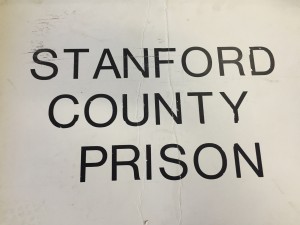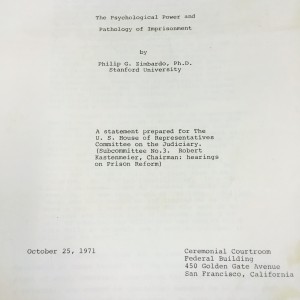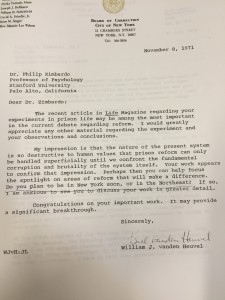The Stanford Prison Experiment conducted by Philip Zimbardo is one of the most well-known experiments in psychology, and is remembered in part due to the shocking nature of the experiment. While the experiment garners a great deal of attention for its unique nature, people may not be as aware of the public’s response to the experiment and the broader implications of the experimental results.

’Stanford County Prison’ sign from the experimental basement prison, courtesy of The Cummings Center for the History of Psychology
Zimbardo designed the study to investigate what makes good people act evil in certain situations. The basement of the Stanford University Psychology Department was transformed into a prison and twenty-four male college students were randomly assigned to be either prison guards or prisoners for two weeks. The experiment was stopped after only six short days because the prison had become a reality for the students. Typical college students had been transformed into completely different people simply by taking on the role of either a member of a powerless group or a member of a controlling group.

One of the prisoner’s outfits from the experiment, courtesy of The Cummings Center for the History of Psychology. The prisoners wore only thin sheets with their number on them for identification.

One of the khaki uniforms worn by the guards during the experiment, courtesy of The Cummings Center for the History of Psychology
The results of this experiment had a much wider realm of application beyond the basement of the psychology building at Stanford University. Throughout the United States an entire prison system was operating on the basic principles that Zimbardo had recreated in his fictional experimental prison. He recognized the problems of that system, as did other people throughout the United States. In a statement to the US House of Representatives in 1971, Zimbardo even called the prison system “the ‘experiment’ which our society is conducting using involuntary subjects.”

The cover page of Dr. Zimbardo’s statement to the U.S. House of Representatives about the Stanford prison experiment and his findings, courtesy of The Cummings Center for the History of Psychology.

A page of one of the daily logs for the experiment, August 18, 1971 courtesy of The Cummings Center for the History of Psychology. Each daily log included a chronology of events through the day and notes about actions of the prisoners and guards.
Zimbardo received letters from a wide range of people including navy officials, lawyers, prisoners, governors, police chiefs, and even a few attorney generals, all praising his efforts and wanting to know more about the results of the experiment to help enact change in the United States prison system. An amazing thing about the experiment that I realized while reading the letters he received was that he sparked a movement. Many of the letters were requesting slide shows of the experiment to show as training videos in addition to asking his opinion about prison reform or telling him about steps being taken to monitor the treatment of prisoners. One person even wrote asking for Zimbardo’s help to stop funding for 2 maximum-security prisons and was successful in his endeavor to stop the prisons from being built.

One of the many letters received by Zimbardo praising the Stanford prison experiment and his work towards prison reform. Courtesy of the Cummings Center for the History of Psychology.
Zimbardo served as a leader and the spark for people across the country that saw problems in the system and wanted to help make a change. He helped them with their cause, being able to provide data that the current prison system in place was detrimental to both guards & prisoners in a 6-day simulation, let alone the real prison system where some people spend the majority of their lives as either guards or prisoners. Through the drastic nature of the Stanford prison experiment Zimbardo was able to grab the attention of the general public and turn it towards the importance of humane treatment for prisoners.